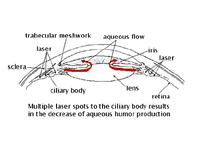|
|
 |
 |
 |
 |
|
|
Diode Laser Transscleral Cyclophotocoagulation (Diode CYC)
|
Printer Friendly
|



Teresa Chen Sachin Chhabra Massachusetts Eye and Ear Infirmary, Harvard Medical School January 9, 2003
|
When is Diode CYC indicated?
Diode CYC is a laser procedure used to treat glaucoma. It is usually only recommended after other more conservative surgeries (such as trabeculectomy filter surgery or tube surgery) have failed. It is also only used if the vision is already very poor.
What is Diode CYC?
Diode CYC is a procedure in which a laser is used to destroy part of the ciliary body, the circumferential structure that lies behind and adjacent to the pheripheral iris (the colored part of the eye.). Since the ciliary body is constantly producing aqueous humor, which is the clear liquid that fills the front of the eye, destruction of part of the ciliary body decreases fluid production in the eye and therefore also decrease intraocular pressure.
How is Diode CYC done?
After the eye is numbed with a local anesthetic, the laser probe is positioned over the ciliary body. The laser beam travels through the sclera (the white part of the eye) to the ciliary body, which is partially destroyed. The sclera is relatively unharmed since the laser energy selectively destroys the darker pigmented ciliary body tissue underneath. Laser spots are applied over 270 degrees of the ciliary body. The goal of the treatment is to leave enough ciliary body alive to produce some aqueous liquid but to destroy enough of it to effectively lower the eye pressure. Multiple treatments may be needed (Figure 1).
What should I expect if I have Diode CYC?
Diode CYC is an outpatient procedure that is done in the eye doctor’s office. A local numbing medication will be injected around the eyeball to numb up the eye. The laser probe, which looks like a small pen, is then placed on the white part of the eye just peripheral to the iris. The laser will be directed INTO your eye towards the ciliary body. Slightly less than 20 spots are usually needed, and the whole procedure takes only a minute or two. Most people experience only minor discomfort during the procedure. After the procedure, patients may have some blurry vision or eye soreness, but this usually resolves within a few days. You will usually have follow-up visits the day after the procedure and the following week. The number and frequency of the visits after that is variable and will depend not only on your type of glaucoma but also on the discretion of your eye doctor. Most people will need to be on two eye drops up to four times a day for a few weeks to help the eye heal after the procedure. This procedure may reduce your need for glaucoma eye drops. If your pressure is not sufficiently lowered with one treatment, repeat treatments are not uncommon.
Will Diode CYC cure my glaucoma?
No. Glaucoma is a chronic disease that requires constant monitoring and treatment. The diode CYC procedure will help to lower your eye pressure. However, it will not reverse any loss of vision that has already occurred. If the diode CYC is successful, loss of vision will slow down. It may not be possible to ever completely stop the loss of vision that occurs with glaucoma.
Can I stop my glaucoma drops after Diode CYC?
Because the effects of the treatment will not be known until a few weeks after the procedure, you may need to continue your eye drops for at least this period of time. Often patients are able to reduce the number of eye drops they are taking. Even if you are taking the same glaucoma medications after the procedure, the laser is a success if your pressure is lower. The need for eye drops long-term after this treatment varies greatly and depends on your type of glaucoma and the rate at which it is progressing.
What are some risks of the laser surgery?
All laser procedures have some risks. The diode CYC treatment will not be done unless the potential benefits outweigh the potential risks. Risks include, but are not limited to, failure of treatment, pain, inflammation, loss of vision, development of eye pressure that is too low (hypotony), and even involution and loss of the eye (phthisis). In general, serious risks are not that common. However, because of the risk of some decrease in vision, this procedure is usually only done when one’s vision and visual prognosis are already poor. You may want to discuss the benefits and risks with your eye doctor if you have further questions.
Does the laser procedure work for everyone?
Unfortunately, the diode CYC procedure does not bring everyone’s pressure down INTO an acceptable range with one treatment. Multiple treatments may be needed. Alternative treatments, which may include Nd:YAG laser or cryotherapy, may be discussed with your physician, however, they are less commonly used because of either decreased efficacy or increased complications. | |
 Figure 1
Figure 1
Multiple laser spots to the ciliary body results in the decrease of aqueous humor production.
|
|
|
The information and recommendations appearing on these pages
are informational only and is not intended to be a basis for diagnosis, treatment
or any other clinical application. For specific information concerning your personal
medical condition, the DJO suggests that you consult your physician.
|
|
 |
 |
 |

|
|
 Welcome, please sign in
Welcome, please sign in  Welcome, please sign in
Welcome, please sign in